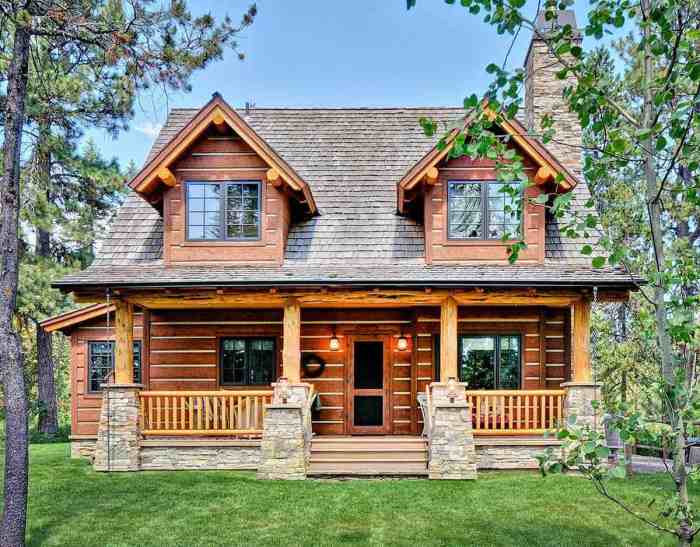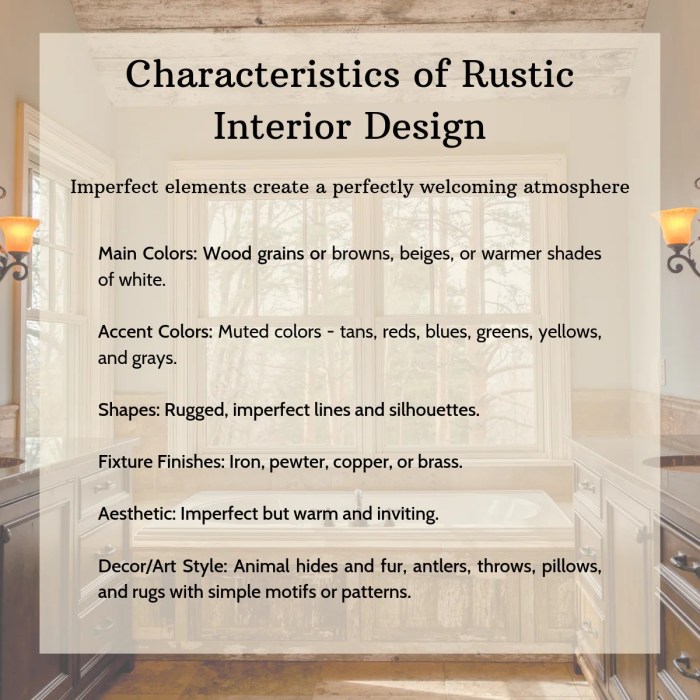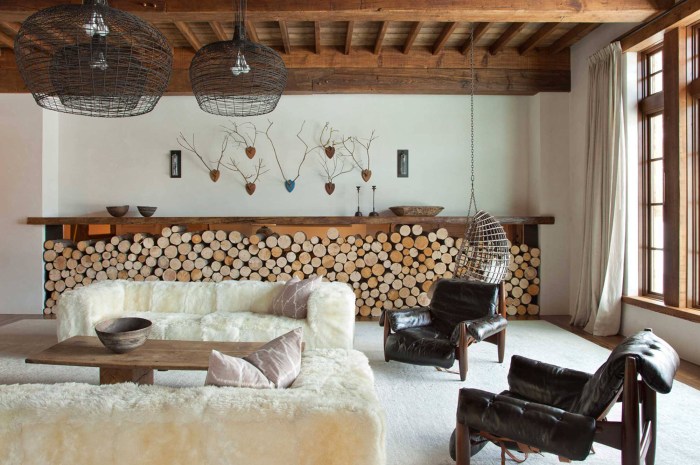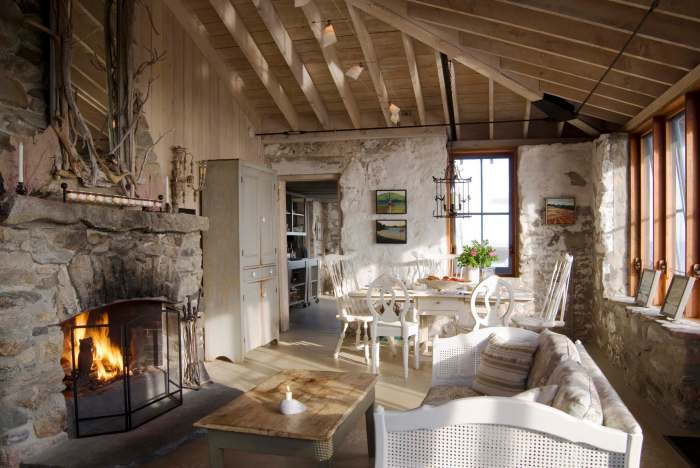Crafting a rustic interior is more than just choosing reclaimed wood; it’s about evoking a sense of warmth, comfort, and connection to nature. This guide provides a straightforward approach to designing a rustic space, breaking down the process into three manageable steps. We’ll explore color palettes inspired by the earth, select furniture and decor that capture the essence of rustic charm, and finally, implement design principles that bring the outdoors in. Prepare to transform your living space into a haven of country comfort.
From understanding the nuances that differentiate rustic style from farmhouse or shabby chic to selecting the perfect furniture and accessories, we’ll cover everything you need to know. Learn how to layer textures, incorporate natural light, and create a space that is both visually appealing and deeply relaxing. This guide offers practical advice and inspiring examples to help you achieve your rustic design vision.
Defining Rustic Style & Choosing a Color Palette

Rustic interior design evokes a sense of warmth, comfort, and connection to nature. It’s a style that embraces imperfection and celebrates the beauty of natural materials, creating spaces that feel both lived-in and inviting. Understanding the core elements of rustic design, along with a thoughtfully chosen color palette, is key to achieving this sought-after aesthetic.
Rustic style relies heavily on a carefully curated color palette that reflects the natural world. Earth tones are paramount, but the key lies in balancing warm and cool shades to prevent the space from feeling monotonous or overly heavy. A successful rustic palette avoids stark contrasts, instead opting for subtle variations and harmonious blends.
Rustic Color Palettes: Examples for Living Rooms and Bedrooms
A well-balanced rustic color scheme enhances the overall feel of the room. For a living room, consider a palette built around warm, earthy neutrals like terracotta, warm beige, and deep browns, accented with cooler tones such as sage green or muted blues. Imagine a living room with terracotta walls, a beige sofa, and deep brown wooden furniture. The sage green could be incorporated through throw pillows or an area rug, while a muted blue could be present in artwork or decorative accessories. This combination offers a comforting warmth while maintaining a sense of spaciousness. Alternatively, a bedroom might benefit from a cooler palette, perhaps using greys and blues as a base, accented with warmer wood tones and natural fibers. Think of a bedroom with grey walls, a light blue bedspread, and dark brown wooden nightstands. The warmth of the wood offsets the cool tones of the walls and bedding, creating a calming and relaxing atmosphere.
Distinguishing Rustic from Farmhouse and Shabby Chic Styles
While rustic, farmhouse, and shabby chic styles share some similarities—an appreciation for natural materials and a relaxed atmosphere—key differences exist. Understanding these differences is crucial for achieving a truly authentic rustic look.
| Style | Key Characteristics | Example Elements |
|---|---|---|
| Rustic | Raw, natural materials; imperfect finishes; emphasis on texture and warmth; earthy color palette; sense of age and history. | Reclaimed wood beams, stone fireplaces, leather furniture, woven textiles. |
| Farmhouse | Clean lines; functional simplicity; white or light-colored walls; vintage or antique accents; focus on practicality and comfort. | Whitewashed wood, vintage signs, open shelving, floral patterns. |
| Shabby Chic | Distressed finishes; pastel colors; delicate floral patterns; vintage and antique furniture; romantic and feminine aesthetic. | Lace, faded fabrics, antique furniture with chipped paint, pastel-colored walls. |
The Use of Reclaimed Wood and Natural Materials in Rustic Design
Reclaimed wood and other natural materials are fundamental to creating a genuine rustic atmosphere. The inherent imperfections and unique character of reclaimed wood—knots, cracks, and variations in color—contribute significantly to the overall aesthetic. These irregularities tell a story, adding depth and authenticity that mass-produced materials lack. Similarly, the incorporation of natural materials like stone, exposed brick, and woven textiles brings a tactile quality and a connection to the natural world, reinforcing the rustic theme. The use of these materials creates a sense of history and permanence, making the space feel both inviting and grounded. The textures and colors of natural materials interact to create visual interest and depth, avoiding a sterile or overly uniform look.
Selecting Rustic Furniture & Decor

Creating a truly rustic interior involves careful consideration of furniture and decor choices. The goal is to evoke a sense of warmth, history, and natural simplicity, balancing comfort with a lived-in aesthetic. The right pieces will transform your space into a cozy haven reflecting the charm of the countryside.
Selecting appropriate furniture and decor is crucial in achieving a cohesive rustic style. The materials, textures, and overall design should complement the chosen color palette and reflect the desired level of rusticity—from subtly country-inspired to heavily reclaimed-wood focused.
Essential Rustic Furniture Pieces
The foundation of any rustic space lies in its furniture. These key pieces will provide both functionality and character, contributing significantly to the overall ambiance.
- Sofa: A large, comfortable sofa in a neutral color like beige or brown, upholstered in durable fabric like linen or cotton, ideally with a slightly worn appearance. Consider a sofa made of reclaimed wood or with exposed wood legs.
- Armchairs: Two or three armchairs in similar style and fabric to the sofa, offering additional seating and creating a conversational area. Leather or a heavy-duty woven fabric would be appropriate choices.
- Coffee Table: A large, sturdy coffee table made of reclaimed wood, perhaps with a slightly distressed finish, providing a focal point for the living room. A coffee table with metal accents can also work well.
- Side Tables: Smaller side tables, possibly made from wood or metal, positioned next to armchairs for drinks and lamps. These can be simpler in design than the coffee table.
- Dining Table: A large, solid wood dining table, preferably made from reclaimed or rustic wood like oak or pine, forming the heart of the dining area. A farmhouse-style table is a classic choice.
- Beds: For bedrooms, choose a sturdy bed frame made of wood, possibly with a headboard featuring natural wood grain or a slightly distressed finish. A wrought-iron bed frame could also fit the aesthetic.
Rustic Living Room Design
This example demonstrates how to arrange furniture and decor to create a welcoming and stylish rustic living room.
Imagine a living room with a large, reclaimed wood coffee table positioned centrally. A comfortable linen sofa sits against one wall, flanked by two armchairs with leather upholstery. A plush, textured rug in earthy tones anchors the seating area. Two small side tables, made of dark wood, stand next to the armchairs, each holding a table lamp with a burlap shade. A large, framed landscape painting with muted colors hangs above the sofa, adding a touch of rustic charm. Lighting is provided by a central chandelier with wrought-iron accents and warm-toned bulbs, complemented by the table lamps. The overall effect is one of relaxed elegance, blending comfort with rustic style.
Rustic Decorative Items
Adding the right decorative items elevates the rustic aesthetic. These details contribute to the overall atmosphere and cohesiveness of the design.
| Item | Material & Texture | Description | Impact on Ambiance |
|---|---|---|---|
| Woven Throw Blanket | Thick, chunky wool or cotton; textured weave | Draped over the sofa or armchairs, adding warmth and texture. | Enhances the cozy and inviting feel. |
| Metal Wall Decor | Wrought iron, aged metal; matte finish | A wall-mounted decorative piece, such as a star or a decorative sign. | Adds a touch of rustic elegance and visual interest. |
| Wooden Candlesticks | Reclaimed wood, natural finish; rough texture | Various sizes placed on the coffee table or mantelpiece. | Creates a warm and inviting glow, adding to the rustic charm. |
| Ceramic Pottery | Earthy tones; rough, handcrafted texture | Vases or bowls displayed on shelves or side tables. | Adds a touch of handcrafted charm and natural beauty. |
Implementing Rustic Design Principles

Successfully implementing rustic design principles involves thoughtfully integrating natural elements and textures to create a space that feels both inviting and authentically rustic. This goes beyond simply choosing rustic furniture; it’s about creating a cohesive atmosphere that evokes the warmth and simplicity of country life. The following sections will detail key aspects of this process.
Incorporating Natural Light and Outdoor Elements
Natural light is paramount in achieving a truly rustic aesthetic. Large windows, ideally with simple, unfussy frames, allow ample sunlight to flood the space, highlighting the natural textures of wood and stone. This abundant light creates a sense of openness and connection to the outdoors, a core element of the rustic style. Imagine a living room with expansive windows overlooking a verdant landscape, the sunlight illuminating the warm tones of a wooden floor and the rough-hewn texture of a stone fireplace. Indoor plants further enhance this connection. Strategically placed potted plants, such as ferns, succulents, or flowering herbs, add visual interest and bring the outdoors in, creating a feeling of organic growth and natural beauty within the home. The combination of natural light and greenery fosters a calming and revitalizing atmosphere, characteristic of a well-executed rustic design.
Rustic Kitchen Design
A rustic kitchen embodies practicality and charm. Countertop materials should reflect this, with options such as butcher block (providing a durable and visually appealing surface) or soapstone (offering a unique, naturally mottled appearance) being ideal choices. Cabinets should be made from solid wood, preferably in a warm, natural finish, like oak or pine. Avoid overly polished or glossy finishes; opt instead for a slightly distressed look that suggests age and character. Appliances should be chosen to complement the rustic aesthetic, avoiding overly modern, sleek designs. Consider appliances with brushed metal or matte black finishes to maintain the overall aesthetic harmony. For example, a farmhouse-style sink with a deep basin and a gooseneck faucet adds to the charm, while a range hood with a simple, functional design completes the look. The overall effect should be one of warmth, functionality, and unpretentious elegance.
Layering Textures and Patterns
The successful execution of a rustic design hinges on the skillful layering of textures and patterns. This creates visual interest and depth, preventing the space from feeling monotonous. Combining different textures – such as the smooth coolness of stone, the warm grain of wood, the soft drape of linen, and the rough texture of woven rugs – introduces a tactile dimension that enriches the overall experience. For instance, a stone fireplace might be juxtaposed with a wooden mantelpiece, a woven rug placed on a hardwood floor, and linen curtains hanging at the window. This interplay of textures adds visual richness and depth to the room.
| Texture | Visual Impact | Example in Rustic Design |
|---|---|---|
| Wood | Warmth, natural beauty, rustic charm | Wooden beams, flooring, furniture |
| Stone | Durability, earthiness, grounding presence | Fireplace surround, countertops, accent walls |
| Fabric (Linen, Wool) | Softness, comfort, visual interest | Curtains, throw pillows, blankets |
| Metal (Wrought Iron, Copper) | Durability, rustic elegance, contrasting element | Lighting fixtures, hardware, decorative accents |
Final Conclusion

Designing a rustic interior is a journey of embracing natural materials, warm color palettes, and thoughtful layering of textures. By carefully selecting furniture, decor, and implementing key design principles, you can create a space that reflects the beauty and tranquility of the countryside. Remember, the key to a successful rustic design lies in creating a harmonious blend of comfort, authenticity, and personal style. Let your creativity flourish and enjoy the process of transforming your home into a rustic retreat.